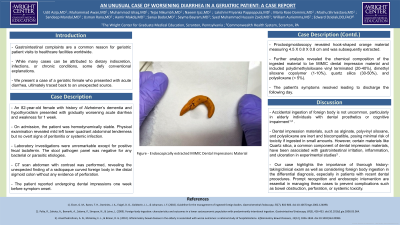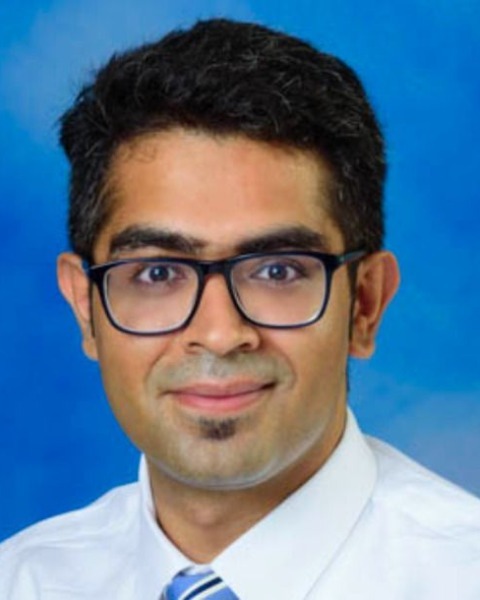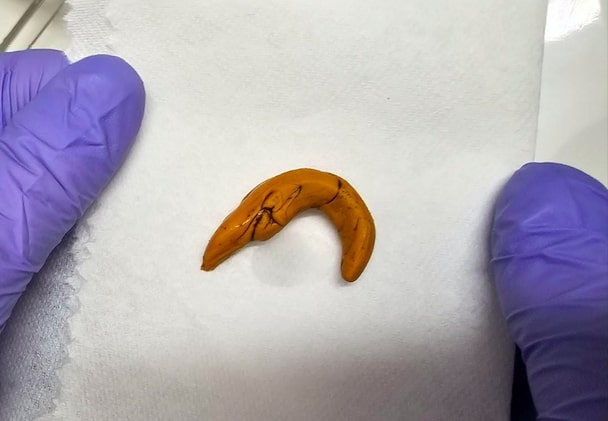Sunday Poster Session
Category: Colon
P0324 - An Unusual Case of Worsening Diarrhea in a Geriatric Patient: A Case Report
Sunday, October 27, 2024
3:30 PM - 7:00 PM ET
Location: Exhibit Hall E

Has Audio

Udit Asija, MD
The Wright Center for Graduate Medical Education
throp, PA
Presenting Author(s)
Udit Asija, MD1, Muhammad Awan, MD1, Muhammad Ishaq, MD1, Tejas Nikumbh, MD1, Naeem Ijaz, MD1, Lakshmi Priyanka Pappoppula, MD2, Maria Rose Dominic, MD2, Mashu Shrivastava, MD2, Sandeep Mandal, MD2, Usman Rana, MD3, Aamir Makda, MD2, Sanya Badar, MD4, Seyma Bayram, MD1, Syed Muhammad Hussain Zaidi, MD2, Wiliam Auriemma, MS5, Edward Dzielak, DO1
1The Wright Center for Graduate Medical Education, Scranton, PA; 2The Wright Center for Community Health, Scranton, PA; 3The Wright Center for Graduate Medical Education, Scanton, PA; 4Wright Center for Graduate Medical Education, Scranton, PA; 5Commonwealth Health System, Scranton, PA
Introduction: Gastrointestinal complaints are a common reason for geriatric patient visits to healthcare facilities worldwide. While many cases can be attributed to dietary indiscretion, infections, or chronic conditions, some defy conventional explanations. We present a case of a geriatric female who presented with acute diarrhea, ultimately traced back to an unexpected source.
Case Description/Methods: An 82-year-old female with history of Alzheimer’s dementia and hypothyroidism presented with gradually worsening acute diarrhea and weakness for 1 week. On admission, the patient was hemodynamically stable. Physical examination revealed mild left lower quadrant abdominal tenderness but no overt signs of peritonitis or systemic infection. Laboratory investigations were unremarkable except for positive fecal lactoferrin. The stool pathogen panel was negative for any bacterial or parasitic etiologies. CT scan abdomen with contrast was performed, revealing the unexpected finding of a radiopaque curved foreign body in the distal sigmoid colon without any evidence of perforation. The patient reported undergoing dental impressions one week before symptom onset. Proctosigmoidoscopy revealed hook-shaped orange material measuring 4.5 X 0.8 X 0.8 cm and was subsequently extracted. Further analysis revealed the chemical composition of the ingested material to be MIMIC dental impression material and included polydimethylsiloxane vinyl terminated (20-40%), dimethylsiloxane copolymer (1-10%), quartz silica (30-50%), and polysiloxane (< 5%). The patient's symptoms resolved leading to discharge the following day.
Discussion: Accidental ingestion of foreign body is not uncommon, particularly in elderly individuals with dental prosthetics or cognitive impairment. Dental impression materials, such as alginate, polyvinyl siloxane, and polysiloxane are inert and biocompatible, posing minimal risk of toxicity if ingested in small amounts. However, certain materials like Quartz silica, a common component of dental impression materials, have been associated with gastrointestinal irritation, inflammation, and ulceration in experimental studies. Our case highlights the importance of thorough history-taking/clinical exam as well as considering foreign body ingestion in the differential diagnosis, especially in patients with recent dental procedures. Prompt recognition and endoscopic intervention are essential in managing these cases to prevent complications such as bowel obstruction, perforation, or systemic toxicity.

Disclosures:
Udit Asija, MD1, Muhammad Awan, MD1, Muhammad Ishaq, MD1, Tejas Nikumbh, MD1, Naeem Ijaz, MD1, Lakshmi Priyanka Pappoppula, MD2, Maria Rose Dominic, MD2, Mashu Shrivastava, MD2, Sandeep Mandal, MD2, Usman Rana, MD3, Aamir Makda, MD2, Sanya Badar, MD4, Seyma Bayram, MD1, Syed Muhammad Hussain Zaidi, MD2, Wiliam Auriemma, MS5, Edward Dzielak, DO1. P0324 - An Unusual Case of Worsening Diarrhea in a Geriatric Patient: A Case Report, ACG 2024 Annual Scientific Meeting Abstracts. Philadelphia, PA: American College of Gastroenterology.
1The Wright Center for Graduate Medical Education, Scranton, PA; 2The Wright Center for Community Health, Scranton, PA; 3The Wright Center for Graduate Medical Education, Scanton, PA; 4Wright Center for Graduate Medical Education, Scranton, PA; 5Commonwealth Health System, Scranton, PA
Introduction: Gastrointestinal complaints are a common reason for geriatric patient visits to healthcare facilities worldwide. While many cases can be attributed to dietary indiscretion, infections, or chronic conditions, some defy conventional explanations. We present a case of a geriatric female who presented with acute diarrhea, ultimately traced back to an unexpected source.
Case Description/Methods: An 82-year-old female with history of Alzheimer’s dementia and hypothyroidism presented with gradually worsening acute diarrhea and weakness for 1 week. On admission, the patient was hemodynamically stable. Physical examination revealed mild left lower quadrant abdominal tenderness but no overt signs of peritonitis or systemic infection. Laboratory investigations were unremarkable except for positive fecal lactoferrin. The stool pathogen panel was negative for any bacterial or parasitic etiologies. CT scan abdomen with contrast was performed, revealing the unexpected finding of a radiopaque curved foreign body in the distal sigmoid colon without any evidence of perforation. The patient reported undergoing dental impressions one week before symptom onset. Proctosigmoidoscopy revealed hook-shaped orange material measuring 4.5 X 0.8 X 0.8 cm and was subsequently extracted. Further analysis revealed the chemical composition of the ingested material to be MIMIC dental impression material and included polydimethylsiloxane vinyl terminated (20-40%), dimethylsiloxane copolymer (1-10%), quartz silica (30-50%), and polysiloxane (< 5%). The patient's symptoms resolved leading to discharge the following day.
Discussion: Accidental ingestion of foreign body is not uncommon, particularly in elderly individuals with dental prosthetics or cognitive impairment. Dental impression materials, such as alginate, polyvinyl siloxane, and polysiloxane are inert and biocompatible, posing minimal risk of toxicity if ingested in small amounts. However, certain materials like Quartz silica, a common component of dental impression materials, have been associated with gastrointestinal irritation, inflammation, and ulceration in experimental studies. Our case highlights the importance of thorough history-taking/clinical exam as well as considering foreign body ingestion in the differential diagnosis, especially in patients with recent dental procedures. Prompt recognition and endoscopic intervention are essential in managing these cases to prevent complications such as bowel obstruction, perforation, or systemic toxicity.

Figure: Endoscopically extracted MIMIC Dental Impressions Material
Disclosures:
Udit Asija indicated no relevant financial relationships.
Muhammad Awan indicated no relevant financial relationships.
Muhammad Ishaq indicated no relevant financial relationships.
Tejas Nikumbh indicated no relevant financial relationships.
Naeem Ijaz indicated no relevant financial relationships.
Lakshmi Priyanka Pappoppula indicated no relevant financial relationships.
Maria Rose Dominic indicated no relevant financial relationships.
Mashu Shrivastava indicated no relevant financial relationships.
Sandeep Mandal indicated no relevant financial relationships.
Usman Rana indicated no relevant financial relationships.
Aamir Makda indicated no relevant financial relationships.
Sanya Badar indicated no relevant financial relationships.
Seyma Bayram indicated no relevant financial relationships.
Syed Muhammad Hussain Zaidi indicated no relevant financial relationships.
Wiliam Auriemma indicated no relevant financial relationships.
Edward Dzielak indicated no relevant financial relationships.
Udit Asija, MD1, Muhammad Awan, MD1, Muhammad Ishaq, MD1, Tejas Nikumbh, MD1, Naeem Ijaz, MD1, Lakshmi Priyanka Pappoppula, MD2, Maria Rose Dominic, MD2, Mashu Shrivastava, MD2, Sandeep Mandal, MD2, Usman Rana, MD3, Aamir Makda, MD2, Sanya Badar, MD4, Seyma Bayram, MD1, Syed Muhammad Hussain Zaidi, MD2, Wiliam Auriemma, MS5, Edward Dzielak, DO1. P0324 - An Unusual Case of Worsening Diarrhea in a Geriatric Patient: A Case Report, ACG 2024 Annual Scientific Meeting Abstracts. Philadelphia, PA: American College of Gastroenterology.
